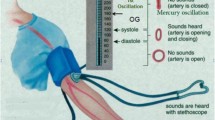Abstract
Arterial stiffness, most often assessed with carotido-femoral pulse wave velocity predicts cardiovascular events but its use in clinical practice remains limited. The 24 h ambulatory monitoring of Blood pressure and timing of Korotkoff sounds (QKD interval) allows an automatic assessment of arterial stiffness and is an independent predictor of cardiovascular events in hypertensive patients. The long term follow up of our cohort of hypertensive patients gave us the opportunity to test the consequences of increased arterial stiffness on the incidence of all causes deaths and to define the populations who could benefit of this measurement beyond risk scores. The sample includes 930 patients (502 males, age 53 ± 13 years, baseline risk SCORE2-OP = 6.70 ± 4.97%) with an average follow up of 12.11 ± 7.4 years (0.3–30). In this population 169 cardiovascular events and 155 deaths were recorded. SCORE2-OP, 24 h Systolic Blood Pressure and arterial stiffness (QKDh) as a continuous or discontinuous variable (normal or reduced) were significantly and independently linked to the occurrence of cardiovascular events or all cause deaths in multivariate Cox model. ROC curves analysis show that measuring arterial stiffness with QKD method offers the best predictive value in patients with low or very low risk scores.




Similar content being viewed by others
Data availability
Data are available from the corresponding author on reasonable request.
References
Vlachopoulos C, Aznaouridis K, Stefanadis C. Prediction of cardiovascular events and all-cause mortality with arterial stiffness: a systematic review and meta-analysis. J Am Coll Cardiol. 2010;55:1318–27.
Blacher J, Safar ME, Pannier B, Guerin AP, Marchais SJ, London GM. Prognostic significance of arterial stiffness measurements in end-stage renal disease patients. Curr Opin Nephrol Hypertens. 2002;11:629–34.
Laurent S, Boutouyrie P, Asmar R, Gautier I, Laloux B, Guize, et al. Aortic stiffness is an independent predictor of all-cause and cardiovascular mortality in hypertensive patients. Hypertension. 2001;37:1236–41.
Mitchell GF, Hwang SJ, Vasan RS, Larson MG, Pencina MJ, Hamburg NM, et al. Arterial stiffness and cardiovascular events: the Framingham Heart Study. Circulation 2010;121:505–11.
Gosse P, Cremer A, Papaioannou G, Yeim S. Arterial stiffness from monitoring of timing of korotkoff sounds predicts the occurrence of cardiovascular events independently of left ventricular mass in hypertensive patients. Hypertension 2013;62:161–7.
Gosse P, Guillo P, Ascher G, Clementy J. Assessment of arterial distensibility by monitoring the timing of Korotkoff sounds. Am J Hypertens. 1994;7:228–33.
Gosse P, Bemurat L, Mas D, Lemetayer P, Clementy J. Ambulatory measurement of the QKD interval normalized to heart rate and systolic blood pressure to assess arterial distensibility - value of QKD100-60. Blood Press Monit. 2001;6:85–9.
Gosse P, Jullien V, Lemetayer P, Jarnier P, Clementy J. Ambulatory measurement of the timing of Korotkoff sounds in a group of normal subjects: influence of age and height. Am J Hypertens. 1999;12:231–5.
SCORE2-OP working group. SCORE2-OP risk prediction algorithms: estimating incident cardiovascular event risk in older persons in four geographical risk regions. Eur Heart J. 2021;42:2455–67.
Visseren FLJ, Mach F, Smulders YM, Carballo D, Koskinas KC, Back M, et al. 2021 ESC Guidelines on cardiovascular disease prevention in clinical practice. Eur Heart J. 2021;42:3227–337.
Cremer A, Butlin M, Codjo L, Coulon P, Ranouil X, Joret C, et al. Determination of central blood pressure by a noninvasive method (brachial BP and QKD interval). J Hypertens. 2012;30:1533–9.
Cremer A, Codjo L, Butlin M, Papaioannou G, Yeim S, Jan E, et al. Determination of central blood pressure by a noninvasive method (brachial blood pressure and QKD interval): a noninvasive validation. J Hypertens. 2013;31:1847–52.
Gosse P, Lasserre R, Minifie C, Lemetayer P, Clementy J. Arterial stiffness evaluated by measurement of the QKD interval is an independent predictor of cardiovascular events. Am J Hypertens. 2005;18:470–6.
Gosse P, Papaioanou G, Coulon P, Reuter S, Lemetayer P, Safar M. Can ambulatory blood-pressure monitoring provide reliable indices of arterial stiffness? Am J Hypertens. 2007;20:831–8.
Laurent S, Mousseaux E, Boutouyrie P. Arterial stiffness as an imaging biomarker: are all pathways equal? Hypertension 2013;62:10–2.
Sequi-Dominguez I, Cavero-Redondo I, Alvarez-Bueno C, Pozuelo-Carrascosa DP, Nunez de Arenas-Arroyo S, Martinez-Vizcaino V. Accuracy of Pulse Wave Velocity Predicting Cardiovascular and All-Cause Mortality. A Systematic Review and Meta-Analysis. J Clin Med. 2020;9:1–13.
Acknowledgements
We thank Stephane Laurent for his very useful comments on this study.
Author information
Authors and Affiliations
Contributions
PG and AC analysed the data and and wrote the first draft, RB, JD and JG made important contributions to the final paper.
Corresponding author
Ethics declarations
Competing interests
The university hospital of Bordeaux has received free Diasys 3 plus from Novacor.
Additional information
Publisher’s note Springer Nature remains neutral with regard to jurisdictional claims in published maps and institutional affiliations.
Supplementary information
Rights and permissions
Springer Nature or its licensor (e.g. a society or other partner) holds exclusive rights to this article under a publishing agreement with the author(s) or other rightsholder(s); author self-archiving of the accepted manuscript version of this article is solely governed by the terms of such publishing agreement and applicable law.
About this article
Cite this article
Gosse, P., Boulestreau, R., Doublet, J. et al. Arterial stiffness (from monitoring of Qkd interval) predict the occurrence of cardiovascular events and total mortality. J Hum Hypertens 37, 907–912 (2023). https://doi.org/10.1038/s41371-022-00797-4
Received:
Revised:
Accepted:
Published:
Issue Date:
DOI: https://doi.org/10.1038/s41371-022-00797-4
- Springer Nature Limited




